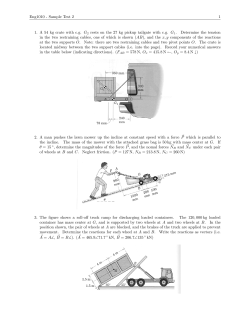
Berlin Buzzwords, June 1st
Understanding databases for
distributed Docker applications
Berlin Buzzwords, June 1st
About Me
•
•
•
London, Melbourne, Leipzig, Berlin
Developer, Designer, Writer,
Musician
Developer Advocate
chris@crate.io
@chrischinch
@crateio
THE SINGLE NODE DATABASE
BACKEND is DEAD
APP SERVER
APP SERVER
APP SERVER
APP SERVER
APP SERVER
APP SERVER
MOBILE &
WEB APPS
THE FUTURE OF DATABASES IS
distributed
MICROSERVICES &
DOCKER
Datacenter Snowflakes
• Deploy in months
• Live for years
Virtualized and Cloud
• Deploy in minutes
• Live for weeks
Docker Containers
• Deploy in seconds
• Live for minutes/hours
Speed enables and encourages
new micro service architectures
Compute Service
• Deploy in milliseconds
• Live for seconds
Now: Zoo of Technologies
Document
Database
Relational
Database
+
Powerful
Search
sync
sharding
+
scaling
Blob Store
replication
2
1
GridFS
HDFS
+
4
3
TRADITIONAL DBs
on DOCKER
CRATE
Crate is...
•
•
•
•
•
•
built on a NoSQL architecture
a distributed SQL Database
(supporting semi-structured records)
extremely simple to install/operate
superfast, powerful search
horizontally scaling, elastic, resilient
eventual-consistent, high
concurrency
>
>
>
>
docker
docker
docker
docker
pull crate:latest
run -d -P crate
run -d -P crate
run -d -p 4200:4200 -p 4300:4300 crate
> docker run -d -p 4200:4200 -p 4300:4300
--volume /data:/data
--env CRATE_HEAP_SIZE=8g
crate crate
-Des.path.data="/data/data1,/data/data2"
-Des.multicast.enabled=false
-Des.network.publish_host=$PRIVATE_IP
-Des.discovery.zen.ping.unicast.hosts=$HOSTS
FOR EVERY
DEVELOPER
•
data is as easy to scale as the
application
•
Familiar, standard SQL Syntax.
•
Automatic Configuration, Sharding
and Replication
•
Support for tables, semi-structured
records and binary data and search.
Ruby
Client DEMO
Compose
Example
crate:
image: crate
ports:
- "4200:4200"
- "4300:4300"
volumes:
- /mnt/data/crate:/data
environment:
CRATE_HEAP_SIZE: 16g
command: crate -Des.cluster.name=my-crate -Des.node.name=crate-1 Des.network.publish_host=cratedemo.dev
node:
build: .
ports:
- "8000:8000"
links:
- crate
Machine & Swarm
> docker-machine create
--driver virtualbox
staging
> eval "$(docker-machine env staging)"
> docker run -d -p 4200:4200 -p 4300:4300 crate
> docker-machine create
-d virtualbox
env-crate
> $(docker-machine env env-crate)
> docker run swarm create
> echo "export TOKEN=xx" >> .bash_profile
> source .bash_profile
> docker-machine create
--driver virtualbox
--swarm
--swarm-master
--swarm-discovery token://${TOKEN}
crate-swarm
> docker-machine create
--driver virtualbox
--swarm
--swarm-discovery token://yy
crate-swarm-node1
> docker-machine ls
> $(docker-machine env --swarm crate-swarm)
> docker info
docker -H tcp://HOST:2376
run -d -p 4200:4200 -p 4300:4300
crate:latest crate
-Des.cluster.name=crate-swarm
-Des.multicast.enabled=false
-Des.transport.publish_host=HOST
-Des.discovery.zen.ping.unicast.hosts="HOSTS"
-Des.discovery.zen.minimum_master_nodes=x
crate.io/blog/cratewith-docker-and-weave
Use Cases
Well Suited
•
•
•
•
High volume, semistructured/
dynamic data
Operational datastore for web
applications that require powerful
fulltext search
Elastic datastore for dynamic
startups
Real time analytics and business
intelligence
Not Well Suited
•
•
•
Systems that require strong
consistency
Systems that require transactions
Strong relational data
https://github.com/crate
http://stackoverflow.com/tags/crate/
IRC #crate on freenode
https://twitter.com/CrateIO
https://fb.me/cratedata
support@crate.io
https://crate.io
Architecture
Distributed
Real-Time SQL
•
•
•
•
Automatic Sharding, Partitioning,
Replication
Optimistic Concurrency Control, ReadAfter Write consistency
Aggregations are superfast and executed
truly distributed by realtime Map/Reduce.
Crate uses Standard SQL* and can handle
thousands of read/write connections per
node
* equi-JOINs to be released soon
Shared-Nothing
Architecture
•
•
•
•
Nodes do not share states
All nodes are equal
Each node is independent & selfsufficient
Each node can perform every task
Horizontal
Scaling
•
•
•
•
Quantity over Quality
Increase amount of (smaller) nodes
instead of scaling a single node
Distributed/parallel computation
power
New way of building webservices
Horizontal
Scaling
•
•
•
•
Quantity over Quality
Increase amount of (smaller) nodes
instead of scaling a single node
Distributed/parallel computation
power
New way of building webservices
© Copyright 2025












